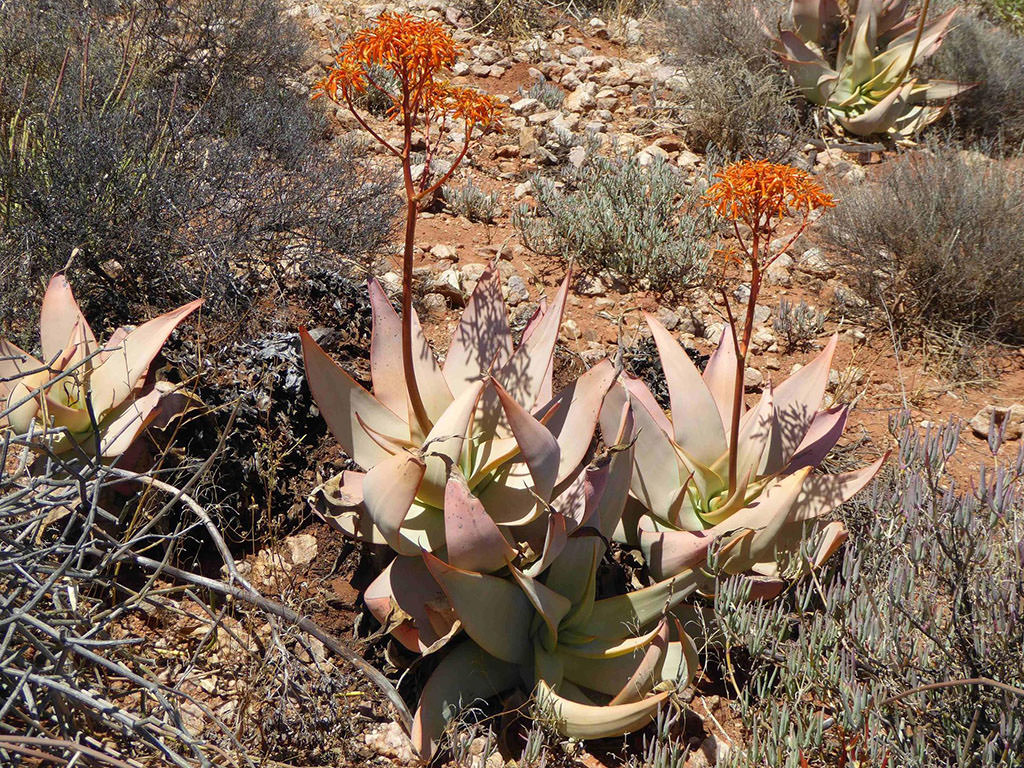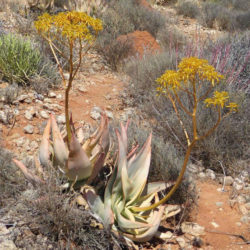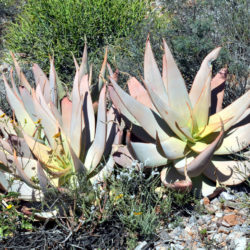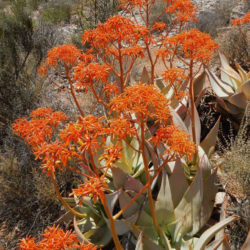Scientific Name
Aloe komaggasensis Kritz. & Jaarsveld
Common Name(s)
Komaggas Aloe, Komaggas Coral Aloe
Synonym(s)
Aloe striata subsp. komaggasensis
Scientific Classification
Family: Asphodelaceae
Subfamily: Asphodeloideae
Genus: Aloe
Origin
This species is endemic to the mountains around Komaggas in the Northern Cape, South Africa, where it grows on quartz slopes.
Description
Aloe komaggasensis, formerly known as Aloe striata subsp. komaggasensis, is a succulent plant that forms stemless or short-stemmed rosettes of gray-green to gray-white leaves. The rosettes grow up to 22 inches (55 cm) in diameter. Leaves are boat-shaped, obscurely striated, and have white to yellowish, finely toothed margins. They are up to 18 inches (45 cm) long and up to 5.2 inches (13 cm) wide. Flowers are yellow or orange and appear in branched, up to 3.3 feet (1 m) tall corymbs in summer.
Etymology
The specific epithet "komaggasensis (ko-mag-ga-SEN-sis)" means "Of or from Komaggas" and refers to the Komaggas, a town in Namakwa District Municipality in the Northern Cape province of South Africa, the native habitat of this species.

How to Grow and Care for Aloe komaggasensis
Light: When growing A. komaggasensis indoors, place your plant in a window with plenty of bright indirect light. Rotate the pot once or twice a week so that all sides of the plant receive equal lighting. Outdoors provide light shade, especially during the hottest parts of the day.
Soil: Plant A. komaggasensis in a well-drained soil mix specially formulated for succulents or make your own. Drainage is essential because too much moisture around roots can cause root rot.
Hardiness: When temperatures shift below 50 °F (10 °C), it is time to bring your plant back inside. A. komaggasensis can withstand temperatures as low as 25 to 50 °F (-3.9 to 10 °C), USDA hardiness zones 9b to 11b.
Watering: This succulent does need regular watering but is very tolerant of drought conditions for short periods. Water deeply, but only when the soil is dry. Cut back on watering during the winter months. Do not let water stand in the rosettes.
Fertilizing: A. komaggasensis generally does not require fertilizer but may benefit from the extra nutrients. Feed with a fertilizer for succulents in spring and summer only. Be sure to follow the label directions.
Repotting: This plant is not particularly fast-growing and will only rarely need repotting. Repot it in the spring in a container a few inches larger in diameter every few years to keep it from becoming rootbound.
Propagation: Propagating A. komaggasensis can be done using the offsets, cuttings, or seeds from a mature plant. Remove offsets from the mother plant or take cuttings with a sharp knife in late spring or early summer. For best results, sow seeds during the warm months.
Learn more at How to Grow and Care for Aloe.
Toxicity of Aloe komaggasensis
A. komaggasensis is not listed as toxic for people and pets.
Links
- Back to genus Aloe
- Succupedia: Browse succulents by Scientific Name, Common Name, Genus, Family, USDA Hardiness Zone, Origin, or cacti by Genus
Photo Gallery
Click on a photo to see a larger version.


